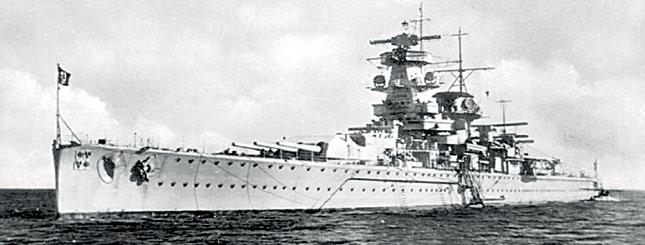
5 minute read
Historic Vessels
from Wavelength #70
Named after Maximilian von Spee, this warship was built in Wilhelmshaven. The Graf Spee was launched on 30 June 1934 and commissioned two years later. At 186m in length, the vessel had disproportionately large guns, which led to the name of “pocket battleship” being used to describe her. The primary armament consisted of six 11-inch (28cm) guns in two triple-gun turrets. This was backed up with eight 5.9-inch (15cm) guns, twenty anti-aircraft guns and a pair of quadruple torpedo launchers. The Graf Spee was fully armoured and the first German warship to be fitted with full radar equipment. Another feature that distinguished her class of vessel was her top speed of 28.5 knots coupled with the ability to accelerate faster than the vast majority of vessels. All these capabilities led to the Graf Spee being deployed in the South Atlantic to fulfil the role of commerce raider just three week after the outbreak of WWII. Having proved highly successful in this role, the Graf Spee attracted the attention of the Royal Navy. Due to the urgent nature of the mission to neutralise the threat posed by the Graf Spee, no fewer than nine squadrons were dispatched to carry out a search and destroy operation. The search component of the mission was aided by the Blue Star vessel, the Doric Star, being able to send a distress call before being captured by the Graf Spee off the coast of South Africa. Eleven days later, the Graf Spee was sighted by ships in Force G under the command of Commodore Henry Howard, who correctly anticipated the German warship’s next move to the River Plate. These comprised the heavy cruiser, HMS Exeter, and the light cruisers HMS Ajax and HMS Achilles at that particular time. The commander of the pocket battleship, Hans Langsdorff, was aware of Force G being in the vicinity of the River Plate estuary and chose to attack. This was a significant blunder as it effectively negated the Graf Spee’s advantage of being able to engage at a distance with the eleveninch guns. Moreover, the move brought her within range of G Force’s weaponry. The conflict began with the Graf Spee engaging HMS Exeter. The latter vessel was struck first. The bridge crew except the Captain and two other perished. Then the two light cruisers joined the battle. HMS Exeter was hit again, but at some point managed to damage the Graf Spee’s fuel processing system, causing the pocket battleship to withdraw the River Plate estuary. Following the withdrawal, Han Langsdorff made his second error when he set a course for Montevideo in neutral Uruguay rather than for the more welcoming Mar del Plata in Argentina. Langsdorff requested a two-week stay to make repairs, but this was met with stern opposition from the British diplomat, Eugen MillingtonDrake, who stated that under the 13th Hague Convention, the Graf Spee should be expelled within 24 hours. The German commander refused, bringing about a stand-off. So, British and French merchant vessels began to sail every 24 hours, thereby preventing the Graf Spee from leaving after having some repairs made by invoking Article 16 of the Convention. The final move saw Langsdorff being fed false intelligence. He was informed that Force G was nearby and relayed this news to the German high command, who ordered him to scuttle the Graf Spee in the River Plate on 17th December 1939.
Admiral Graf Spee
Advertisement
Panzerschiff "Admiral Graf Spee". Source: www.wikipedia.org
Source: www.thought.co.com, www.wikipedia.org
Sponsored by the granddaughter of Chancellor Otton von Bismarck, the Bismarck was built by Blohm and Voss in Hamburg. This fortress of a warship was launched on 14th February 1939. After being commissioned in August of the same year, testing was conducted in Kiel Bay. At 450.5m in length, the Bismarck was the largest warship afloat. Despite her size and thick armour, the Bismarck could attain a speed of 30 knots. The Bismarck’s first voyage began on 19th May 1941, when the massive vessel embarked on Operation Rheinubung to attack Allied convoys carrying oil, food and other basic supplies to Great Britain from across the Atlantic. Shadowed by the heavy cruiser, Prinz Eugen, the floating fortress caused havoc in the effort to cut off British supplies with the aim of starving the British into surrender. Having acquired information about the Bismarck’s location, the Royal Navy ordered a fleet to track down the German warship. In this fleet were HMS Prince of Wales and HMS Hood, Britain’s largest battleship. On 24th May 1941, the first blows between HMS Hood and the Bismarck were exchanged in the Denmark Strait. The Bismarck struck first and decisively. HMS Hood’s ammunition magazine was hit, causing a massive explosion. All but 3 of the 1421 souls aboard managed to escape. The Bismarck had a ruptured fuel tank and was taking on water, so Captain Ernst Lindermann ordered a withdrawal. Determined to gain revenge, Admiral John Tovey demanded that the Bismarck be hunted down prior to reaching safe haven. Before the Bismarck could obtain protection from the Luftwaffe, the aircraft carrier, HMS Ark Royal, dispatched bombers to launch an attack. In poor visibility, however, friendly fire hit HMS Sheffield. Fortunately, there was no severe damage as the warheads failed to detonate.

Bismarck
German Battleship Bismarck in World War II. Source: www.thoughtco.com
After rearming, the bombers along with biplanes located the Bismarck and were able to target the undefended rudders (the Bismarck’s Achilles’ heel), thereby incapacitating the German warship’s steering. Only able to move in circles, the Bismarck could only wait to the destroyed. On 27th May, three British warships closed in and completed the mission. Only 110 of the 2102 on board survived. There can be no doubt that the Graf Spee and Bismarck were fine examples of naval engineering. Therefore, the biggest chinks in their armour were human misjudgements. These took the form of poor leadership decisions in the case of the Graf Spee and the air of arrogance and invincibility brought about through the idea that the Bismarck was unsinkable. If a lesson can be learned from these stories, it is that leaders must have excellent decision making skills and an appropriate mindset in order to be effective.


